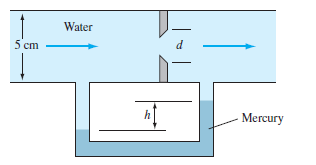
Elements Of Electromagnetics
7th Edition
ISBN: 9780190698614
Author: Sadiku, Matthew N. O.
Publisher: Oxford University Press
expand_more
expand_more
format_list_bulleted
Concept explainers
Question
Water at 20°C flows through the orifice in Fig. ,
which is monitored by a mercury manometer. If d = 3 cm,
(a) what is h when the flow rate is 20 m3/h and (b) what is
Q in m3/h when h = 58 cm?

Transcribed Image Text:Water
5 cm
Mercury
Expert Solution
This question has been solved!
Explore an expertly crafted, step-by-step solution for a thorough understanding of key concepts.
Step by stepSolved in 3 steps

Knowledge Booster
Learn more about
Need a deep-dive on the concept behind this application? Look no further. Learn more about this topic, mechanical-engineering and related others by exploring similar questions and additional content below.Similar questions
- A large tank is continuously filled with water to a depth of 15 m. A 0.1 m diameter hole is located 8 m above the bottom of the tank. Calculate the Volumetric flowrate through the hole. [Answers in m³/s, Numerical Value only] y2 .. v,=0 h V1 y1 Answer: Type here to searcharrow_forwardO.S. A vertical orifice is 10 cm. square and has an actual flow of 28 Ips with Cv=0.95, Cv = 0.62 as shown in the figure. If the liquid is oil (s.g. = 0.85), what is the head, h in meter over the orifice is required? determine the theoretical velocity of the jet determine the theoretical flow (Ips).arrow_forwardEthanol at 20°C flows down through a modern venturi nozzleas in Fig. . If the mercury manometer reading is4 in, as shown, estimate the flow rate, in gal/min.arrow_forward
- Pro er hydrant nozzle in Fig. 1 has inlet and outlet diameters, D₁ = 8 cm and D₂ 1.0 cm. Water at 20°C flows through the nozzle at 0.001 m³/s and exits to the atmosphere. The atmospheric pressure is 101.3 KPa. Neglect the weight of the piping and nozzle. Compute: a) The exit fluid velocity, V2, ( b) The inlet pressure, Pl c) The horizontal force which must be resisted by the = flange bolts S d) The moment acting on the flange neglect the weight of the hydrant and water 10 m 8 cm Fig. 1: Water hydrant 1arrow_forwardAn engineer is designing a cooling jet for a manufacturing process that requires water at 60 °F to be discharged from the nozzle shown below at a rate of 81 gallons/minute. (a) What gage pressuren psi) at Point A is required to produce the desired flowrate? (b) After initial testing, it was determined that air should be used instead of water for the cooling process. However, the engineer is concerned that compressibility could affect performance. Explain how you would modify the Bernoulli equation to account for the effect of air being a compressible fluid. A = 1.0 in.² -A=4.0 in.2arrow_forwardExample(1) Consider the water siphon shown in Fig. below. Assuming that Bernoulli's equation is valid, (a) find an expression for the velocity V2 exiting the siphon tube. (b) If the tube is 1 cm in diameter and z = 60 cm, z2 =25 cm, estimate the flow rate in m²/s. Estimate the pressure at point(3) if 23=90cw z =0---- V2 НОНЕWORК Estimate the pressure at point (3 ) if Z3= 90cm.arrow_forward
- Two water tanks, each with base area of 1 ft2, are connectedby a 0.5-in-diameter long-radius nozzle as in Fig. .If h = 1 ft as shown for t = 0, estimate the time for h(t) todrop to 0.25 ft.arrow_forwardUsing the figure depicted below, perform the following: (a) Calculate the minimum height h at which cavitation occurs. Indicate on the figure where the cavitation occurs. (b) Calculate the volume flowrate (in m³/s) if h = 25 cm. Be sure to state all assumptions. Note that section 2 opens to atmosphere. D1 = 5 cm h D2 = 10 cm Free Jet (1) 2 Water at 20°Carrow_forwardWhat is the total force acting on a 90 degrees pipe bend if the flow pressure is 3 x105 Pa, the flowrate is 0.1m3/s and the specific gravity of the fluid is 0.7. The pipe diameter is 10cm and the weight of the fluid can be neglected (remember to consider both force components).arrow_forward
- Having trouble with this problem. Please include your assumptions, explanation, and any sketches. Any help would be appreciated!arrow_forwardA necked-down section in a pipe flow, called a venturi,develops a low throat pressure that can aspirate fluidupward from a reservoir, as in Fig. UsingBernoulli’s equation with no losses, derive an expressionfor the velocity V 1 that is just sufficient to bring the reservoirfl uid into the throat.arrow_forwardCould i please have the asnwers and workings out to the attached question.arrow_forward
arrow_back_ios
arrow_forward_ios
Recommended textbooks for you
 Elements Of ElectromagneticsMechanical EngineeringISBN:9780190698614Author:Sadiku, Matthew N. O.Publisher:Oxford University Press
Elements Of ElectromagneticsMechanical EngineeringISBN:9780190698614Author:Sadiku, Matthew N. O.Publisher:Oxford University Press Mechanics of Materials (10th Edition)Mechanical EngineeringISBN:9780134319650Author:Russell C. HibbelerPublisher:PEARSON
Mechanics of Materials (10th Edition)Mechanical EngineeringISBN:9780134319650Author:Russell C. HibbelerPublisher:PEARSON Thermodynamics: An Engineering ApproachMechanical EngineeringISBN:9781259822674Author:Yunus A. Cengel Dr., Michael A. BolesPublisher:McGraw-Hill Education
Thermodynamics: An Engineering ApproachMechanical EngineeringISBN:9781259822674Author:Yunus A. Cengel Dr., Michael A. BolesPublisher:McGraw-Hill Education Control Systems EngineeringMechanical EngineeringISBN:9781118170519Author:Norman S. NisePublisher:WILEY
Control Systems EngineeringMechanical EngineeringISBN:9781118170519Author:Norman S. NisePublisher:WILEY Mechanics of Materials (MindTap Course List)Mechanical EngineeringISBN:9781337093347Author:Barry J. Goodno, James M. GerePublisher:Cengage Learning
Mechanics of Materials (MindTap Course List)Mechanical EngineeringISBN:9781337093347Author:Barry J. Goodno, James M. GerePublisher:Cengage Learning Engineering Mechanics: StaticsMechanical EngineeringISBN:9781118807330Author:James L. Meriam, L. G. Kraige, J. N. BoltonPublisher:WILEY
Engineering Mechanics: StaticsMechanical EngineeringISBN:9781118807330Author:James L. Meriam, L. G. Kraige, J. N. BoltonPublisher:WILEY

Elements Of Electromagnetics
Mechanical Engineering
ISBN:9780190698614
Author:Sadiku, Matthew N. O.
Publisher:Oxford University Press

Mechanics of Materials (10th Edition)
Mechanical Engineering
ISBN:9780134319650
Author:Russell C. Hibbeler
Publisher:PEARSON

Thermodynamics: An Engineering Approach
Mechanical Engineering
ISBN:9781259822674
Author:Yunus A. Cengel Dr., Michael A. Boles
Publisher:McGraw-Hill Education

Control Systems Engineering
Mechanical Engineering
ISBN:9781118170519
Author:Norman S. Nise
Publisher:WILEY

Mechanics of Materials (MindTap Course List)
Mechanical Engineering
ISBN:9781337093347
Author:Barry J. Goodno, James M. Gere
Publisher:Cengage Learning

Engineering Mechanics: Statics
Mechanical Engineering
ISBN:9781118807330
Author:James L. Meriam, L. G. Kraige, J. N. Bolton
Publisher:WILEY